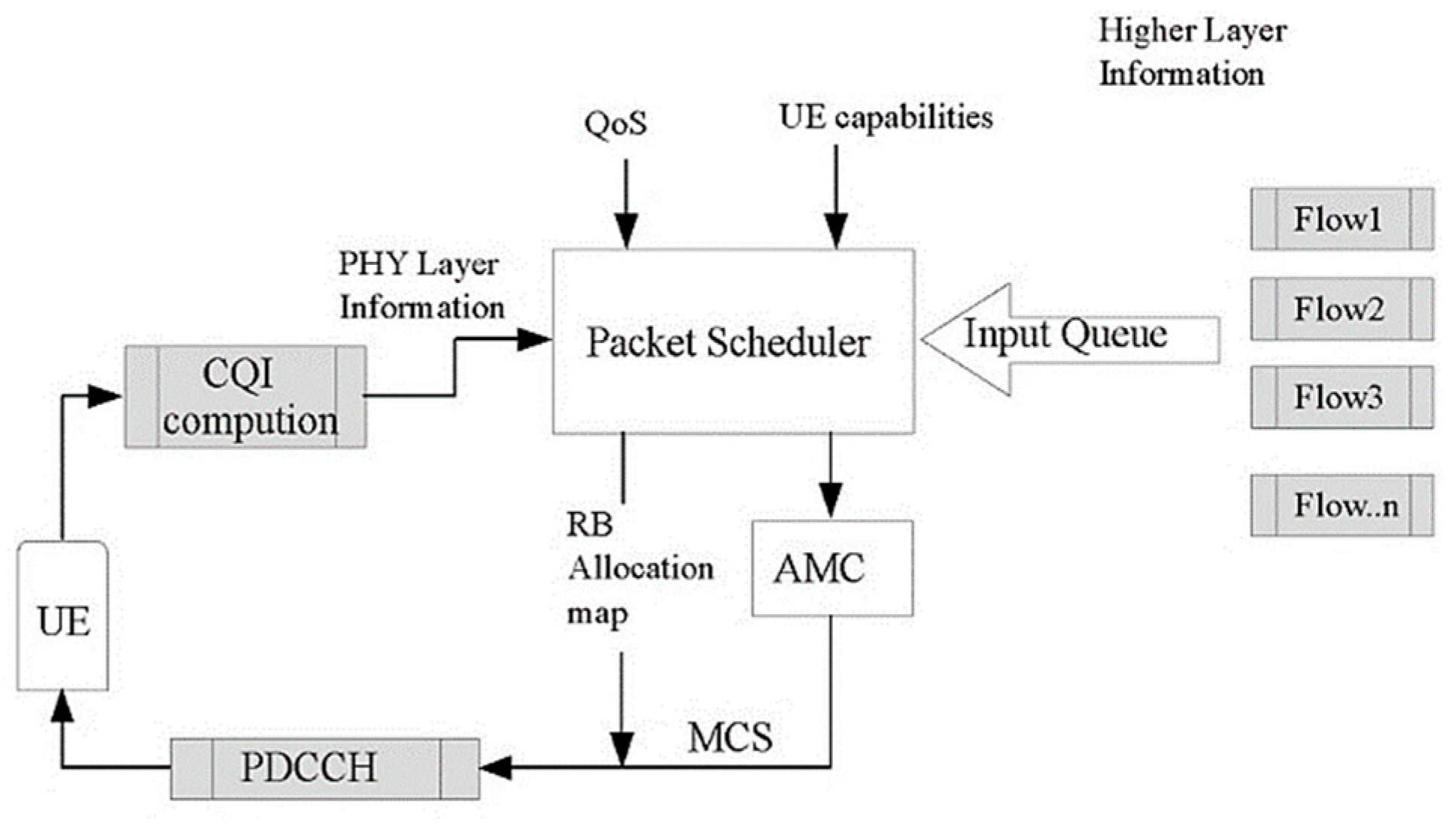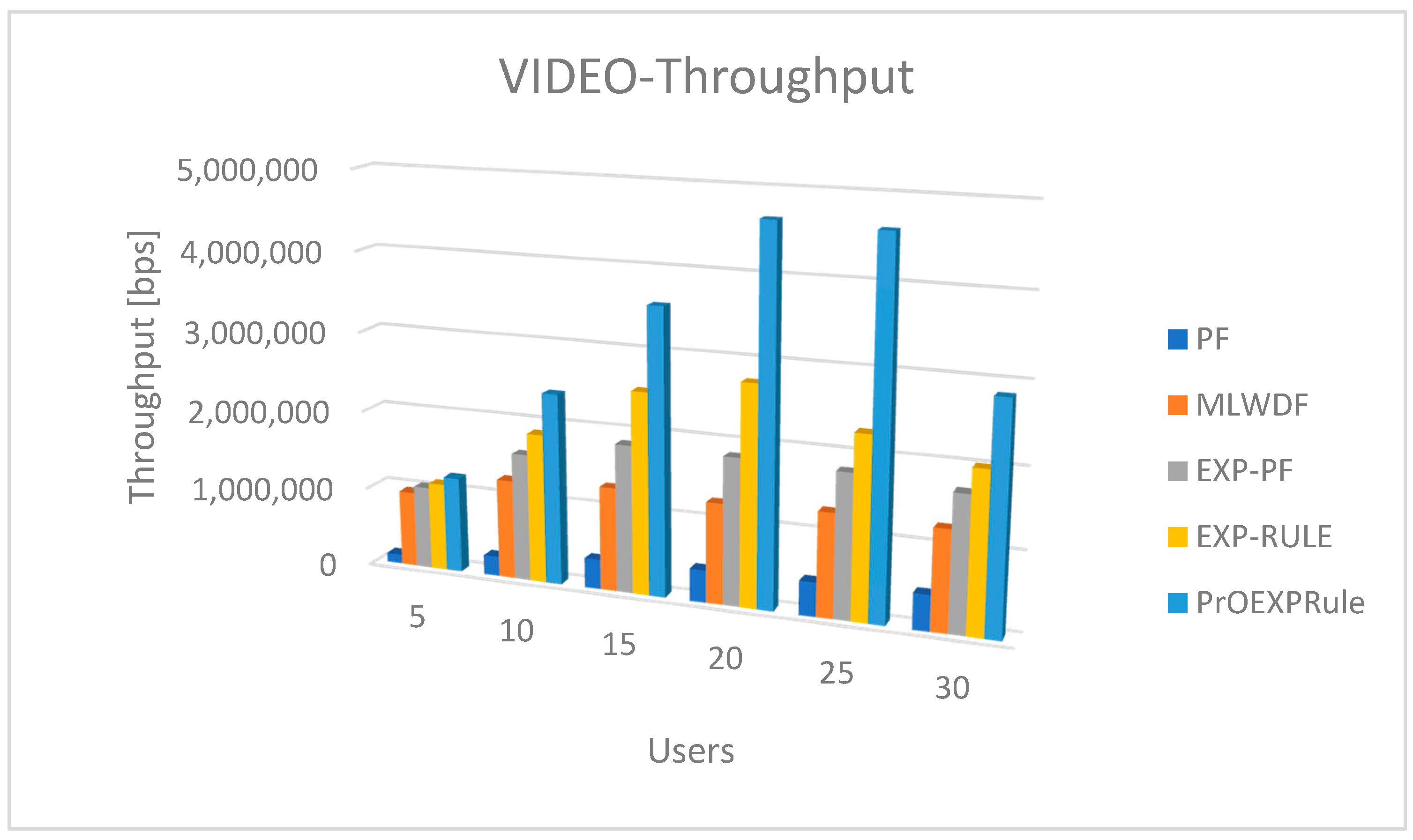QoS-Aware Scheduling Algorithm Enabling Video Services in LTE Networks
Abstract
1. Introduction
2. Related Work
3. LTE Schedulers
3.1. Proportional Fair (PF) Scheduler
3.2. Modified Largest Weighted Delay First (MLWDF) Scheduler
3.3. Exponential PF (EXP/PF) Scheduler
3.4. Exponential Rule (EXPRULE) Scheduler
4. Proposed PrOEXPRule Scheduler Design
4.1. Simulation Environment
4.2. Proposed Optimisation Exponential Rule (PrOEXPRule) Scheduling
- An RB will be provided to a user if ;
- denotes the HOL packet delay corresponding to time and user , and ;
- denotes the packet jitter corresponding to the transmission at time t and user k.
- Algorithm PrOEXPRule (Algorithm 1)
| Algorithm 1: The proposed PrOEXPRule Scheduling. |
| 1 input 2 k //user equipment count; 3 Nrb //number of resource block RBs; 4 rk //data rate required for user k; 5 Pk //priority index n for user k (0 or 1); 6 ar //RBs available for serving each user; 7 Nk //estimated number of RBs required by each user; 8 Dk //head of line delay per user k; 9 Tk //delay threshold per user k; 10 //arrival data rate for each user; 11 //service time; 12 rk //achievable data rate; 13 ARp//RBs allocated to non-priority users; 14 ARnp//average channel gain; 15 Jj //jitter for each packet unit j; 16 initialisations: 17 define L for RBs list at each TTI; 18 define F for selected flow list that will be scheduling at each TTI; 19 20 34 if Pi = 1 then ARp hold; rk ; 36 update: 37 calculate: 38 update: ; 39 40 if ( 41 42 compute M[i][j] and allocate Nk based on (17); 43 else 44 compute M[i][j] based on ; 45 end; 46 end; 47 end; 48 end; |
5. Result and Discussion
5.1. Video Packet Loss Ratio
5.2. Video Fairness
5.3. Video Delay
5.4. Video Throughput
6. Conclusions
Author Contributions
Funding
Data Availability Statement
Conflicts of Interest
References
- Nohrbog, M. The Mobile Broadband Standard LTE. 3GPP. 2013. Available online: http://www.3gpp.org/technologies/keywords-acronyms/98-lte (accessed on 1 November 2019).
- Alsahag, A.M.; Ali, B.M.; Noordin, N.K.; Mohamad, H. Maximum rate resource allocation algorithms with multiuser diversity and QoS support for downlink OFDMA based WiMAX system. Telecommun. Syst. 2016, 63, 1–14. [Google Scholar] [CrossRef]
- Capozzi, F.; Piro, G.; Grieco, L.A.A.; Boggia, G.; Camarda, P. Downlink packet scheduling in LTE cellular networks: Key design issues and a survey. IEEE Commun. Surv. Tutor. 2013, 15, 678–700. [Google Scholar] [CrossRef]
- Müller, C.F.; Galaviz, G.; Andrade, Á.G.; Kaiser, I.; Fengler, W. Evaluation of Scheduling Algorithms for 5G Mobile Systems. Stud. Syst. Decis. Control 2018, 143, 213–233. [Google Scholar]
- Al-Sakkaf, A.G.; Khan, S.; Abdullah, K. QoS downlink schedulers in LTE towards 5G network. In Proceedings of the 2015 IEEE 12th Malaysia International Conference on Communications (MICC), Kuching, Malaysia, 23–25 November 2015; pp. 225–229. [Google Scholar]
- Monikandan, B.S.; Sivasubramanian, A.; Babu, S.P.K.; Venkatesan, G.K.D.P.; Arunachalaperumal, C. Channel aware optimized proportional fair scheduler for LTE downlink. Peer Peer Netw. Appl. 2020, 13, 2135–2144. [Google Scholar] [CrossRef]
- Mesbahi, N.; Dahmouni, H. Delay and jitter analysis in LTE networks. In Proceedings of the 2016 International Conference on Wireless Networks and Mobile Communications (WINCOM), Fez, Morocco, 26–29 October 2016; pp. 122–126. [Google Scholar]
- Li, D.; Liu, X.; Wang, Y.; Liu, Y. Importance-Driven Downlink Resource Scheduling for Video Transmission over LTE. In Proceedings of the 2018 6th IEEE International Conference on Network Infrastructure and Digital Content, IC-NIDC 2, Guiyang, China, 22–24 August 2018; pp. 110–114. [Google Scholar]
- Pal, D.; Vanijja, V. Effect of network QoS on user QoE for a mobile video streaming service using H.265/VP9 codec. Procedia Comput. Sci. 2017, 111, 214–222. [Google Scholar] [CrossRef]
- Dahmouni, H.; Girard, A.; Ouzineb, M.; Sansò, B. The impact of jitter on traffic flow optimization in communication networks. IEEE Trans. Netw. Serv. Manag. 2012, 9, 279–292. [Google Scholar] [CrossRef]
- Masli, A.; Mansoor, A.M.; Ahmed, F.Y.H. Analysis the performance of Downlink Video Streaming Scheduling Algorithm in LTE Network. Solid State Technol. 2020, 63, 947–957. [Google Scholar]
- Zarai, F.; Boudriga, N.; Obaidat, M.S. Universal Mobile Telecommunications System. In Handbook of Computer Networks; John Wiley & Sons, Inc.: Hoboken, NJ, USA, 2011; pp. 699–715. [Google Scholar]
- Leng, Q.; Wei, Y.H.; Han, S.; Mok, A.K.; Zhang, W.; Tomizuka, M. Improving control performance by minimizing jitter in RT-Wi-Fi networks. In Proceedings of the 2014 IEEE Real-Time Systems Symposium, Rome, Italy, 15 January 2015; pp. 63–73. [Google Scholar]
- Mukhopadhyay, A.; Das, G. A proposal for WLAN-EPON integration that reduces video traffic jitter in presence of mixed traffic. In Proceedings of the 2016 IEEE International Conference on Advanced Networks and Telecommunications Systems (ANTS), Bangalore, India, 6–9 November 2016; pp. 1–6. [Google Scholar]
- Hammad, K.; Moubayed, A.; Primak, S.; Shami, A. Investigating the energy-efficiency/delay jitter trade-off for VoLTE in LTE downlink. In Proceedings of the IEEE International Symposium on Personal, Indoor and Mobile Radio Communications, PIMRC, Montreal, QC, Canada, 8–13 October 2017; pp. 1–7. [Google Scholar]
- Verger, L.M.; Chaudhary, M.; Tackin, O.E.; Elrad, O.M.; Vasudevan, S.; Elangovan, T.; Shao, T. Enhancing Jitter Buffer Performance through Radio Level Feedback. U.S. Patent No. 9,107,159, 11 August 2015. [Google Scholar]
- Dahmouni, H.; Girard, A.; Sansò, B. An analytical model for jitter in IP networks. Ann. Telecommun. 2011, 67, 81–90. [Google Scholar] [CrossRef]
- Hammad, K.; Moubayed, A.; Primak, S.L.; Shami, A. QoS-Aware Energy and Jitter-Efficient Downlink Predictive Scheduler for Heterogeneous Traffic LTE Networks. IEEE Trans. Mob. Comput. 2018, 17, 1411–1428. [Google Scholar] [CrossRef]
- Yaqoob, J.I.A.Y.; Pang, W.L.; Wongand, S.K.; Chan, K.Y. Enhance Exponential Rule Scheduling Algorithm for Real-Time in LTE Network. IJECE 2020, 10, 1993–2002. [Google Scholar] [CrossRef]
- Kumar, P.; Kumar, S.; Dabas, C. Comparative Analysis of Downlink Scheduling Algorithms for a Cell Affected by Interference in LTE Network. Ann. Data Sci. 2016, 3, 135–153. [Google Scholar] [CrossRef]
- Sulthana, S.F.; Nakkeeran, R. Study of Downlink Scheduling Algorithms in LTE Networks. J. Netw. 2014, 9, 3381–3391. [Google Scholar] [CrossRef]
- Nwawelu, U.N.; Ani, C.; Ahaneku, M.A. Comparative Analysis of the Performance of Resource Allocation Algorithms in Long Term Evolution Network. Niger. J. Technol. 2017, 36, 163–171. [Google Scholar] [CrossRef]
- Afroz, F.; Heidery, R.; Shehab, M.; Sandrasegaran, K.; Shompa, S.S. Comparative Analysis of Downlink Packet Scheduling Algorithms in 3GPP LTE Networks. Int. J. Wirel. Mob. Netw. 2015, 7, 1–21. [Google Scholar] [CrossRef][Green Version]
- Piro, G.; Grieco, L.A.; Boggia, G.; Capozzi, F.; Camarda, P. Simulating LTE Cellular Systems: An Open-Source Framework. IEEE Trans. Veh. Technol. 2011, 60, 498–513. [Google Scholar] [CrossRef]
- Angri, I.; Mahfoudi, M.; Najid, A.; El Bekkali, M. Exponential MLWDF (EXP-MLWDF) Downlink Scheduling Algorithm Evaluated in LTE for High Mobility and Dense Area Scenario. Int. J. Electr. Comput. Eng. 2018, 8, 1618. [Google Scholar] [CrossRef]





| Parameters | Value |
|---|---|
| Number of Simulators | 5 |
| Number of Clusters | 1 |
| Number of Cells in a Cluster | 4 |
| Initial User Count | 1 |
| User Interval | 5 |
| Maximum Users | 30 |
| Bandwidth | 5 MHz |
| RB Numbers | 25 |
| Slot Duration | 0.5 s |
| Scheduling Time (TTI duration) | 1 ms |
| Cell Radius | 1.5 km |
| Modulation Scheme | QPSK, 16QAM, 64QAM |
| Mobile Speed | 120 s |
| User Speed | 3 km/h |
| Video Bitrate | 256 kbps |
| Max Delay | 0.1 s |
| Flow Duration | 120 s |
| Simulation Duration | 120 s |
| Frame Structure | FDD |
| Video Bitrate | 242 kbps |
Publisher’s Note: MDPI stays neutral with regard to jurisdictional claims in published maps and institutional affiliations. |
© 2022 by the authors. Licensee MDPI, Basel, Switzerland. This article is an open access article distributed under the terms and conditions of the Creative Commons Attribution (CC BY) license (https://creativecommons.org/licenses/by/4.0/).
Share and Cite
Masli, A.A.; Ahmed, F.Y.H.; Mansoor, A.M. QoS-Aware Scheduling Algorithm Enabling Video Services in LTE Networks. Computers 2022, 11, 77. https://doi.org/10.3390/computers11050077
Masli AA, Ahmed FYH, Mansoor AM. QoS-Aware Scheduling Algorithm Enabling Video Services in LTE Networks. Computers. 2022; 11(5):77. https://doi.org/10.3390/computers11050077
Chicago/Turabian StyleMasli, Amal Abulgasim, Falah Y. H. Ahmed, and Ali Mohamed Mansoor. 2022. "QoS-Aware Scheduling Algorithm Enabling Video Services in LTE Networks" Computers 11, no. 5: 77. https://doi.org/10.3390/computers11050077
APA StyleMasli, A. A., Ahmed, F. Y. H., & Mansoor, A. M. (2022). QoS-Aware Scheduling Algorithm Enabling Video Services in LTE Networks. Computers, 11(5), 77. https://doi.org/10.3390/computers11050077






